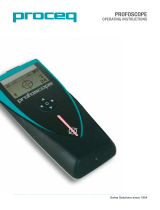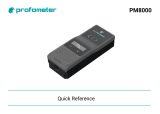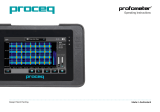
Localization accuracy ±10 mm (± ½ in)
Minimum distance between objects Depth range 5...55 mm (¼ ...2¹/₈ in): 55 mm(2¹/₈in)
Depth range >55 mm (2¹/₈ in): Distance / depth factor
>1.5
Power source 4x1.5V (AAA) LR03 alkaline batteries
Battery life at 20 °C 10 h
Operating temperature range -15…+50°C (5° F to 122° F)
Automatic cut-out 5 min
Storage temperature range (dry) -25…+63°C (-13°F to 145°F)
Relative air humidity
95%
Protection class IP 54 (protection against dust and water spray)
Weight (including batteries) 420 g (0.99 lb)
Dimensions(LxWxH) 237mmx104mmx47mm(9.4inx4inx2in)
4 Safety instructions
In addition to the information relevant to safety given
in each of the sections of these operating instructions,
the following points must be strictly observed at all
times.
The tool is designed to detect ferrous metals (steel
rebars) and non-ferrous metals (copper, aluminium)
in concrete, brick, drywall and under plaster surfaces
in accordance with the information provided in the
technical data section.
4.1 Basic information concerning safety
a) Do not render safety devices ineffective and do
not remove information and warning notices.
b) Keep children away from the tool.
c) Check that the tool functions correctly each time
before use.
d) Check the display after switching the tool on. The
display should show all symbols within 1 second.
e) Check to ensure that the tool is able to calibrate
itself after switching on.
f) Operation of the tool in the proximity of pregnant
women is not permissible.
g) Rapidly changing detection conditions may lead to
inaccurate readings.
h) Use the tool only within its specified limits. Do not
use the tool on materials containing tensioning
cables or stainless steel objects.
i) Do not use the tool in the proximity of medical
instruments and appliances.
j) Do not drill at positions where the tool has located
an object.
k) The warnings shown in the display must always
be observed.
l) Do not use the tool in the proximity of electro-
magnetic interference (e.g. electric breakers in
operation).
m) Take the influences of the surrounding area into
account. Do not use the tool where there is a risk
of fire or explosion.
n) Make sure that the display area can be easily
read (e.g. do not touch the display area with the
fingers, keep the display area clean).
o) Do not use the tool if it is defective.
p) Always keep the detection area clean.
q) The accuracy of the tool is influenced by the base
material. If the tool is unable to calibrate itself cor-
rectly, scanning errors may result.
r) When the tool is unable to calibrate itself automatic-
ally, a warning appears in the display.
s) Use of the tool in the proximity of persons with a
cardiac pacemaker is not permissible.
4.2 Proper organization of the workplace
a) Avoid unfavorable body positions when working
on ladders or scaffolding. Make sure you work
fromasafestanceandstayinbalanceatall
times.
b) When the tool is brought into a warm environment
from very cold conditions, or vice-versa, allow it
to become acclimatized before use.
c) Use the tool only within its specified limits.
d) Observe the accident prevention regulations ap-
plicable in your country.
4.3 Electromagnetic compatibility
Although the tool complies with the strict requirements of
the applicable directives, Hilti cannot entirely rule out the
possibility of the tool being subject to interference caused
by powerful electromagnetic radiation, leading to incor-
rect operation. Check the accuracy of the tool by taking
measurements by other means when working under such
conditions or if you are unsure. Likewise, Hilti cannot rule
out the possibility of interference with other devices (e.g.
aircraft navigation equipment). The tool complies with the
requirements of class A; The possibility of interference
occurring in a domestic environment cannot be excluded.
en
13
Printed: 27.10.2015 | Doc-Nr: PUB / 5137821 / 000 / 01
















